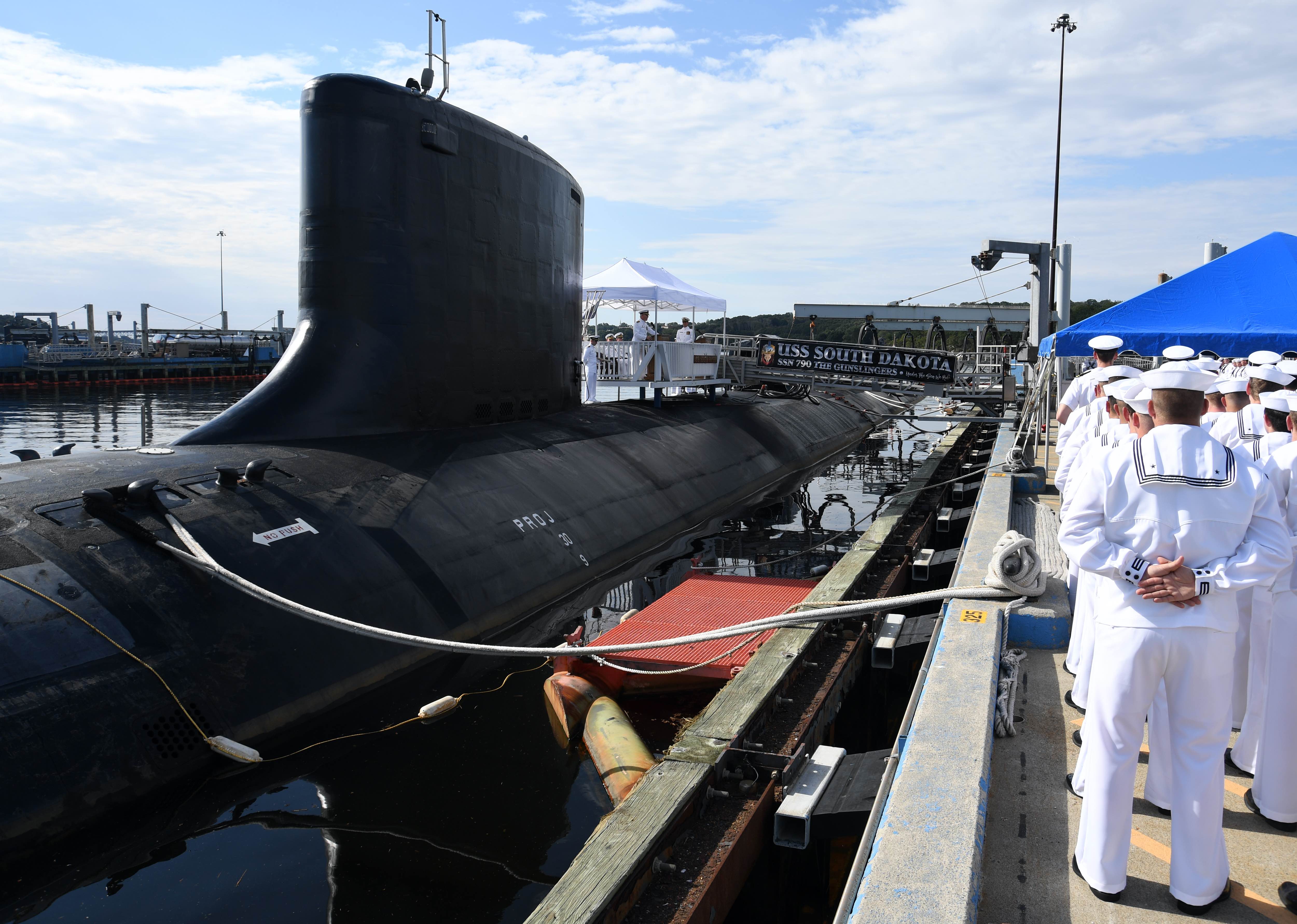
The U.S. nuclear attack submarine inventory will experience a nearly decade-long dip due to the AUKUS partnership, according to a new Congressional Budget Office analysis of U.S. naval shipbuilding.
To support selling three to five Virginia-class attack boats to the Royal Australian Navy, the attack boat inventory will decrease in the mid-2030s, as shipyards won’t be able to deliver Virginia-class boats to absorb the loss of the sale to Australia.
The dip, estimated to start in 2037, will keep U.S. attack boat inventory in the high 40s to low 50s for about a decade, meaning the Navy will remain short of its goal of 66 attack submarines in the fleet.
CBO analyzed three scenarios, with the U.S. selling different combinations of new and used types of Virginia-class boats, all under the Navy’s first shipbuilding plan. The first plan, several officials have told USNI News, is the most austere of the three proposals in the annual shipbuilding blueprint.
“To purchase 3 to 5 additional replacement submarines during that period, the Navy would need to build 1.9 to 2.6 SSNs per year, depending on which alternative it followed,” according to the report, which was referring to the 2030s and the three shipbuilding plans the service proposed earlier this year.

The Navy estimates that industry won’t build two boats per year until 2028, USNI News reported earlier this year. The current rate is about 1.3 a year, defense officials have told USNI News.
The Biden administration in March laid out a multi-pronged long-range plan for the United States, the United Kingdom and Australia to pursue the AUKUS pact, a technology sharing agreement that includes providing the nuclear propulsion tech to the Australians. Selling several Virginia boats to the RAN in the 2030s is meant to bridge the gap while the three nations train the Australian sailors and workforce to maintain and build the boats, and develop an indigenous industrial base capability.
But the CBO report, released annually to assess the Navy’s shipbuilding plan and cost estimates, raises questions about how the U.S. industrial base will build enough Virginia-class boats to achieve the 66 attack submarine goal, while also selling to the Australians and building the Columbia-class ballistic missile submarine.
“Over the past several years, the time between the appropriation of funds for SSNs and their delivery has increased from six years (when the Navy was building 1 SSN per year) to nine years,” the CBO report reads. “Therefore, it would be very difficult and expensive for the U.S submarine industry to increase production of attack submarines during a period when it must also build 1 Columbia class ship per year. “
The CBO analysis did not account for the Biden administration’s $3.4 billion supplemental budget request released last week for the submarine industrial base.
Download the document here.
The U.S. industrial base is currently building about 1.3 attack submarines per year, falling short of the two-per-year cadence the Navy has been buying submarines for about a decade. Former Chief of Naval Operations Adm. Mike Gilday has said that the industrial base must build more than two Virginias per year if the U.S. is to sell some of the boats to the Australians.
Testifying before Congress on Wednesday, several Pentagon and Navy officials told lawmakers that the Defense Department’s Fiscal Year 2024 legislative proposals – which include language that would allow Australia to contribute funds to bolster the U.S. industrial base and the U.S. to sell the Virginia boats to the Australians – are crucial to the success of AUKUS.
“It’s absolutely critical that we execute on this. It’s going to uplift our industrial base,” Vice Adm. Bill Houston, the commander of Naval Submarine Forces, told the House Armed Services Committee. “It’s going to uplift our undersea forces. And it uplifts all nations’ ability to defend and have a stable Indo-Pacific region that’s open for all countries. And so the continued support we get via these legislative proposals – which are absolutely critical to training, to accepting money, to do the information transfers we need – are absolutely critical to benefitting all three countries.”
Meanwhile, the CBO report also analyzed the Navy’s other shipbuilding programs and included cost estimates. The Navy’s Landing Ship Medium – the platform meant to shuttle Marines between islands and shorelines in an island-hopping campaign scenario and previously known as the Light Amphibious Warship – is estimated to cost $270 million. That’s nearly double the $100 to $150 million per hull cost that Navy and Marine Corps officials have previously estimated for the program. Naval Sea Systems Command declined to provide a cost-per-hull estimate earlier this month when asked by USNI News.
CBO also analyzed the LPD(X) amphibious ship program that would follow the LPD-17 Flight II program and concluded that its respective estimates are not that far apart.

“The Navy estimates that LPD(X)s would cost $2.2 billion to $2.3 billion per ship; CBO estimates that the cost would range between $2.5 billion and $2.7 billion per ship,” the report reads. “Most of the difference lies in the fact that CBO’s constant-dollar estimates account for historically observed real growth in the costs of labor and materials in the shipbuilding industry, whereas the Navy’s estimates do not.”
CBO’s FY 2024 analysis found that the DDG(X) program, the next-generation destroyer meant to follow the Arleigh Burke-class, would cost about $3.2 to $3.5 billion per hull across the Navy’s three shipbuilding plans. Last year’s estimate from CBO for that program was about $3.4 billion per hull.
As for SSN(X), or the next-generation attack submarine, CBO puts the cost at $7.7 to $8 billion per hull, or more than $1 billion more than the Navy’s estimate.
“CBO estimates that the average cost of each SSN(X) would range from $7.7 billion to $8.0 billion under the Navy’s three alternatives. The Navy estimates that each SSN(X) would cost $6.7 billion to $7.0 billion in all three cases,” the report reads.





